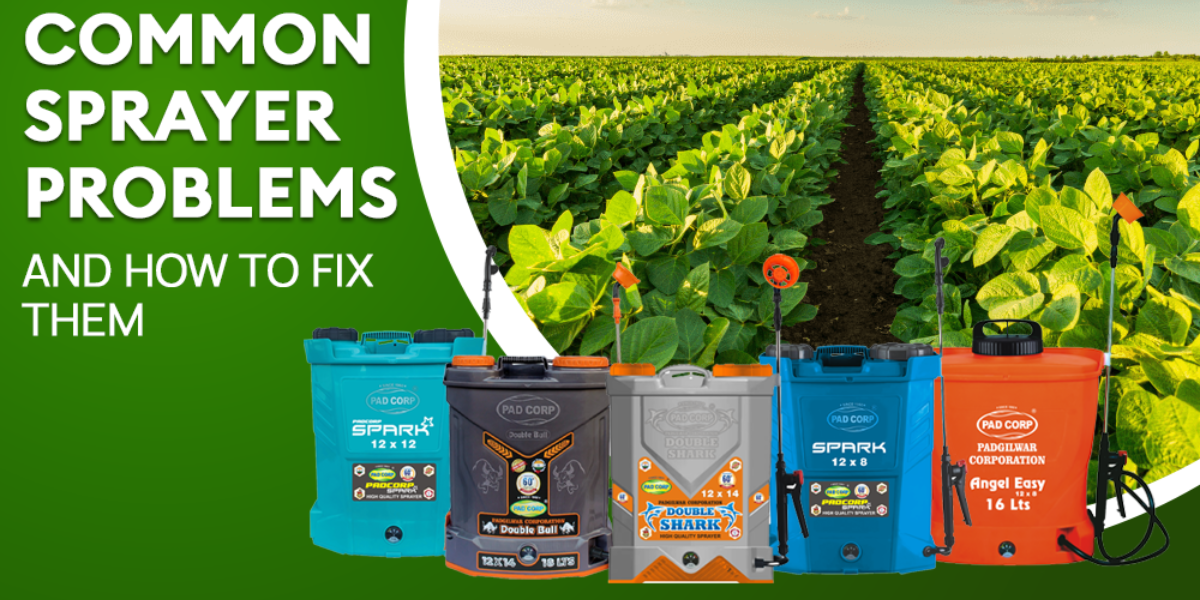A sprayer is an essential agricultural and gardening equipment, used to apply fertilisers, herbicides, or pesticides. Sprayers, like any mechanical tool, can develop problems impairing their performance. These issues, ranging from clogged nozzles to leaking hoses, are frustrating.
Padgilwar Corporation, the leading agricultural equipment manufacturer in Pune, helps you with a wide range of easy-to-handle sprayers that require low maintenance. While using sprayers, you may come across a few problems but they can be solved with simple troubleshooting techniques. In this blog, we will look at some common sprayer issues and offer practical solutions to help you get your sprayer back up and running.
Clogged Nozzles
Clogged nozzles are one of the most common sprayer problems. Debris and residue from spraying materials can accumulate over time, obstructing the nozzle openings. As a result, spray patterns may be uneven or completely blocked. To solve this issue, you can follow these steps:
Step 1: Disconnect the sprayer and release the pressure.
Step 2: Take the nozzle or nozzle tip-off.
Step 3: To remove any buildup, rinse the nozzle in warm, soapy water.
Step 4: Clear any remaining debris from the nozzle openings with a small brush or needle.
Step 5: Reassemble the nozzle and test the sprayer to ensure even coverage.
Leaking Hoses or Connections
Hose or connection leaks can result in wasted spraying materials and decreased efficiency. To resolve this issue:
Step 1: Disconnect the sprayer and release the pressure.
Step 2: Examine the hoses and connections for visible damage or loose connections.
Step 3: Tighten or replace any loose connections or hoses.
Step 4: To create a tight seal, apply a small amount of plumber’s tape to the threaded connections.
Step 5: Check the sprayer for any remaining leaks.
Weak or Inconsistent Spray
A weak or inconsistent spray pattern may indicate a problem with the pump or pressure settings, which can be resolved by following these steps:
Step 1: Examine the pump for signs of wear or damage.
Step 2: Check that the pump is properly primed and that there is enough spraying material in the tank.
Step 3: Adjust the pressure settings per the manufacturer’s recommendations.
Step 4: To ensure proper flow, clean or replace the strainer and filter.
Step 5: If the problem persists, consult the sprayer’s user manual or contact the manufacturer.
Overheating
When used for extended periods of time or in high-temperature environments, some sprayers can overheat. This can result in decreased performance or even sprayer damage. To avoid overheating:
Step 1: Stick to the manufacturer’s recommendations for usage time and rest periods.
Step 2: If the sprayer is hot to the touch, turn it off and wait for it to cool before proceeding.
Step 3: If possible, avoid using the sprayer in extreme temperatures.
Step 4: Clean and maintain the sprayer on a regular basis to avoid excessive buildup, which can contribute to overheating.
Conclusion Sprayers from Padcorp can be highly beneficial for you if you understand its common issues and their solutions. It can save time, money, and frustration. Remember to maintain your sprayer on a regular basis to avoid problems in the first place. If you run into more complicated problems, feel free to contact us. Besides, consult the user manual that comes with our sprayer for specific troubleshooting instructions and safety precautions. With proper care and troubleshooting, you can keep your sprayer in good working order for many years.



